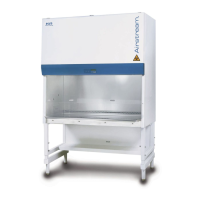Chapter 5 - Maintenance and Re-certification of the Cabinet
Esco products generally provide years of trouble-free operation however like all equipment they require
maintenance and service. Maintenance and service should be carried out by trained personnel. Esco offers
training courses to equip service providers with the latest skills, information and tools to successfully maintain
and service Esco products. For more information on the nearest training course, please contact Esco.
Service providers should familiarize themselves with the basic operating principles of products before working
on them. Suitable references include information in this Manual or brochures which may be downloaded from
the Esco web site.
Biological safety cabinets generally require:
• Re-certification, when:
o The cabinet is re-located.
o Cabinet performance is suspect.
o After filter or blower replacement.
o At least once a year or based on your risk assessment.
o During recertification:
Cabinet airflow velocities and flow patterns are verified against the manufacturer’s
specifications and relevant international standards
Filters are scan-tested to ensure they do not leak.
Operator comfort tests may be performed.
If airflow velocities are found to be off setpoint, adjustments are made as part of
the certification process before final values are recorded.
• Airflow alarm calibration, when:
o The cause of the airflow alarm cannot be determined.
o Re-certification indicates the displayed airflow deviates by > 0.02 m/s (4 fpm) from actual
measured velocities (only for products with airflow velocity displays).
• Decontamination before filter or fan replacement, or as specified.
• Filter replacement, when:
o The filters are clogged and the fan(s) are unable to compensate for the filter loading.
o Filter leaks which cannot be repaired are found during scan-testing.
Note: Before filter replacement, the cabinet must be decontaminated.
• Fan replacement (typically rare) if failure occurs.
• Routine maintenance also includes:
o Fluorescent lamp(s) replacement - typically once every 2 years.
o UV lamp replacement - typically once every 1 year.
5.1. Installation Check
1. Check that the cabinet was installed away from air conditioning unit, heater, door, ceiling lamp, or
any other equipment that affect cabinet airflow to ensure the sensor reading on top of cabinet is
undisturbed.
2. Make sure the holes on the exhaust airflow sensor are not blocked, and the holes on the exhaust and
downflow airflow sensors are perpendicular to the airflow path. If the airflow sensor is moved, then
the microprocessor requires re-calibration.
3. Make sure the holes on the exhaust and downflow airflow sensors tube are perpendicular to the
airflow path. If the airflow sensor tube is moved, then the microprocessor requires re-calibration.
4. Make sure that the exhaust filter is not blocked, and the downflow diffuser is properly installed.
5. Make sure that the downflow diffuser is properly installed.
6. Check that the fan duty cycle matches with the value given on the test report.

